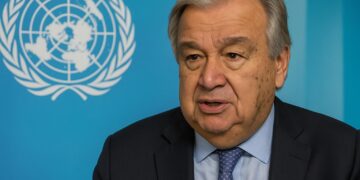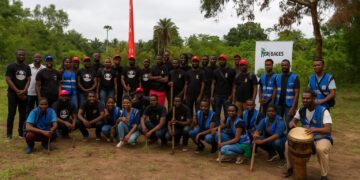National drive gains momentum
In Brazzaville, a three-day workshop opened on 22 October, bringing thirty national and international experts around one table to refine Congo’s strategic plan against peste des petits ruminants, a highly contagious viral disease afflicting goats and sheep.
Director General of Livestock Kaya-Tobi, presiding for the Ministry of Agriculture, underlined that validation would anchor the plan to state commitments and unlock resources for implementation across all ten departments.
Aligning with continental blueprint
Participants are benchmarking every paragraph of the national draft against the 2015 FAO-WOAH Global Strategy, the African Union’s panafrican framework and the Economic Community of Central African States’ regional guidance to ensure harmonised priorities, indicators and evaluation tools.
This exercise avoids duplication, eases cross-border surveillance and positions Congo to access multilateral funding windows earmarked for transboundary animal diseases, officials confirmed.
Why PPR still matters for investors
First detected locally in 2005, PPR continues to circulate in several districts, eroding rural incomes and constraining the expansion plans of meat processors and feed suppliers whose supply chains start with healthy small ruminant flocks.
Ministry data show mortality can wipe out up to 90 percent of an infected herd within days, translating into annual national losses estimated at CFA 10 billion, while collateral effects include higher protein prices and pressure on import bills.
For financiers eyeing agribusiness projects, a credible eradication roadmap reduces animal-health risk premiums and supports projections for downstream asset utilisation, from abattoirs to cold-chain infrastructure.
Financing the new roadmap
The draft budget, now under discussion, pairs sovereign allocations with potential grants from the World Bank’s Regional Disease Surveillance Systems Enhancement programme and the African Development Bank’s livestock initiative, according to workshop sources.
Officials argue that dedicating less than 0.1 percent of national expenditure for five consecutive years could immunise the country’s estimated 3.2 million goats and sheep, a cost–benefit ratio they describe as ‘decisive’.
A phased approach is proposed: initial epidemiological mapping, followed by mass vaccination, targeted surveillance and, finally, proof-of-absence certification to unlock new export markets in the sub-region.
Data, labs and digital surveillance
Congo’s veterinary services plan to expand rapid-test capacity at Madingou and Owando laboratories, while equipping field agents with tablets linked to a cloud dashboard that provides real-time geotagged alerts.
The system, modelled on platforms deployed in Rwanda and Senegal, should tighten reporting lags from weeks to hours and feed evidence-based decisions on vaccine pre-positioning, experts said.
Communication as a risk hedge
Beyond the cold numbers, the forthcoming communication plan will target herder associations, women’s cooperatives and local radio stations to demystify vaccine safety and create demand pull.
Behavioural scientists from the University of Marien Ngouabi are advising on messaging that respects cultural perceptions of livestock ownership while stressing the broader public-good dimension of disease freedom.
Regional synergies underpin success
Workshop participants highlighted the value of the Central African Regional Animal Health Centre in sharing outbreak intelligence and synchronising vaccination calendars along porous borders with Gabon and Cameroon.
Congo will also seat a veterinary attaché within the ECCAS secretariat to follow up on resource mobilisation and technical assistance, a decision viewed as signalling high-level political buy-in.
Measurable milestones toward 2030
The validated document is expected to set interim targets for 2025—80 percent herd immunity and less than five reported outbreaks—and 2028, when serological surveys should confirm virus elimination in at least seven departments.
Ultimately, authorities plan to request official PPR-free status from WOAH by 2030, transforming the small-ruminant sector into a springboard for food security, rural employment and value-added processing.
Governance and risk management
To minimise fiduciary risk, the ministry proposes a steering committee chaired by the Prime Minister’s office, integrating auditors from the Supreme State Control and representatives of producer groups to supervise procurement of vaccines and cold-chain equipment.
Quarterly dashboards will publish budget execution rates, doses administered and outbreak maps, a transparency move applauded by the Congolese Federation of Livestock Cooperatives as ‘a platform that can finally bridge herders and policymakers’.
Climate and One Health co-benefits
Eradication is expected to lower methane emissions per kilogram of meat, since healthier animals reach market weight faster; the plan therefore aligns with Congo’s updated Nationally Determined Contribution under the Paris Agreement, officials noted.
The health ministry also links the initiative to broader One Health objectives, as controlling PPR reduces the need for indiscriminate antibiotic use and mitigates the risk of antimicrobial resistance spilling into human populations.
Next steps for investors
Once the plan is formally endorsed, agencies will open tenders for vaccine supply, cold-room refurbishment, solar fridges and mobile data solutions; foreign bidders must partner with local firms holding veterinary service licences.
Development finance institutions have signalled readiness to co-finance viable proposals under blended-finance structures that cap interest rates at single digits, an incentive likely to accelerate private participation in what remains a largely untapped segment.
Analysts at BGFIBank anticipate that successful PPR eradication could add up to CFA 35 billion annually to rural GDP through higher survival rates, improved genetics and the scaling of smallholder feedlots that supply urban supermarkets.












































